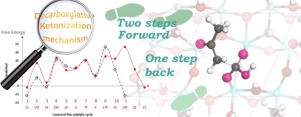Molecular Catalysis ( IF 4.6 ) Pub Date : 2017-08-12 , DOI: 10.1016/j.mcat.2017.07.019 Alexey V. Ignatchenko , James P. McSally , Marc D. Bishop , Joshua Zweigle

|
Catalytic mechanism of acetic and isobutyric acids mixture conversion into two symmetrical and one cross-ketone product on monoclinic zirconia (111) surface was extensively modeled by Density Functional Theory for periodic structures. Several options were evaluated for each mechanistic step by calculating their reaction rate constants. The best option for each kinetically relevant step was chosen by matching calculated rates of reaction with experimental values.
Four zirconium surface atoms define each catalytic site. The most favorable pathway includes condensation between surface carboxylates, one of which is enolized through alpha-hydrogen abstraction by lattice oxygen. Condensation of gas phase molecules with the enolized carboxylate on surface is less attainable.
The kinetic scheme considers all steps being reversible, except for decarboxylation. The equilibrium constant of the enolization step and the rate constant of the condensation step define the global reaction rate for non-bulky acetic acid. For bulky isobutyric acid, decarboxylation step is added to the kinetic scheme as kinetically significant, while hydrocarbonate departure may also compete with the decarboxylation. Electronic and steric effect of alkyl substituents on the decarboxylation step is disclosed.
The cross-selectivity is controlled by both condensation and decarboxylation steps. None of the mechanistic steps require metal oxide to be reducible/oxidizable.
中文翻译:

从头开始研究通过缩合为β-酮酸然后脱羧使单斜氧化锆上的羧酸交叉酮化的机理
利用密度泛函理论对乙酸和异丁酸混合物在单斜晶氧化锆(111)表面上转化为两个对称的和一个交叉酮产物的催化机理进行了广泛的建模。通过计算其反应速率常数,对每个机械步骤评估了几种选择。通过将计算的反应速率与实验值进行匹配,可以选择每个动力学相关步骤的最佳选择。
四个锆表面原子定义了每个催化位点。最有利的途径包括表面羧酸盐之间的缩合,其中之一通过晶格氧通过α-氢提取而被烯醇化。气相分子与烯醇化的羧酸酯在表面上的缩合难以实现。
动力学方案认为除脱羧作用外所有步骤都是可逆的。烯醇化步骤的平衡常数和缩合步骤的速率常数定义了非大体积乙酸的整体反应速率。对于大体积的异丁酸,在动力学方案中增加了脱羧步骤,因为它具有动力学上的重要性,而碳氢化合物的离去也可能与脱羧竞争。公开了烷基取代基在脱羧步骤上的电子和空间效应。
交叉选择性受缩合和脱羧步骤的控制。机械步骤都不要求金属氧化物是可还原/可氧化的。

























 京公网安备 11010802027423号
京公网安备 11010802027423号